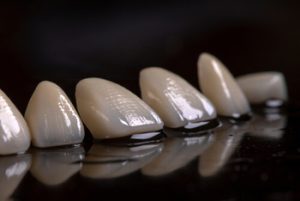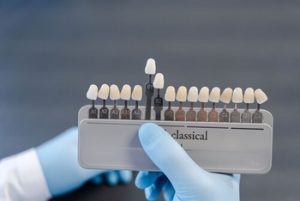A dental crown is a common dental restoration used to protect and strengthen damaged or weakened teeth. Whether you need a crown due to tooth decay, root canal treatment, or a fractured tooth, this procedure can help restore both function and aesthetics.
But what does the dental crown placement process involve? What types of dental crowns are available, and how do you take care of them? In this guide, we’ll explore the entire process, from tooth preparation to aftercare, ensuring you know exactly what to expect.
What Is a Dental Crown?
A dental crown, often referred to as a tooth crown, is a protective covering designed to restore the shape, size, strength, and function of a weakened, damaged, or decayed tooth. Available in different materials such as ceramic crowns, metal crowns, and porcelain crowns, it is customised to suit individual dental needs.
Why Do You Need a Dental Crown?
 You may need a dental crown if:
You may need a dental crown if:
- You have a weak tooth that requires reinforcement.
- You have a broken tooth that cannot be fixed with a simple filling.
- You have a decayed tooth with extensive decay, requiring additional support.
- You have undergone a root canal treatment, which often weakens the tooth.
- You have a missing tooth and need a crown over a dental implant.
- You want to improve the appearance of discoloured teeth.
How Dental Crowns Give Your Smile a Second Chance
A dental crown is more than just a cap—it’s a long-term solution that restores and protects weakened teeth, ensuring both functionality and aesthetics. Here’s how dental crowns restore your teeth and improve your oral health.
1. Strengthens Weakened Teeth
If you have a weak tooth due to extensive decay, fractures, or a root canal treatment, a dental crown provides the reinforcement needed to prevent further damage. It serves as a protective barrier, preserving the integrity of the tooth structure and preventing further damage.
2. Restores Natural Functionality
Chewing and biting can become difficult when a tooth is damaged. Dental crowns improve function by covering the prepared tooth, allowing you to eat comfortably without discomfort.
3. Enhances Appearance with a Natural Look
Modern ceramic crowns, porcelain crowns, and zirconia crowns are crafted to closely resemble your natural tooth colour, seamlessly integrating with your surrounding teeth for a lifelike appearance. This makes crowns an excellent option for restoring discoloured teeth or damaged front teeth.
4. Protects Teeth After a Root Canal Treatment
A root canal treatment removes infected tissue but leaves the tooth fragile. A dental crown reinforces the tooth underneath, preventing breakage and prolonging its lifespan.
5. Saves a Tooth from Extraction
If a tooth has extensive decay but still has sufficient tooth structure, a dental crown treatment can save it from extraction. This helps preserve your adjacent teeth and prevents the need for a dental implant or bridge.
6. Covers and Supports Dental Implants
For a missing tooth, a dental implant acts as the root, while a permanent dental crown serves as the replacement tooth. Together, they create a strong and long-lasting solution for tooth loss.
7. Provides Long-Lasting Protection
With proper dental crown care, a crowned tooth can last 10-15 years or longer, offering a durable and cost-effective solution for tooth restoration.
8. Prevents Further Dental Issues
By covering and protecting a decayed tooth or broken tooth, a tooth crown reduces the risk of infection, fractures, and misalignment of other teeth.
Types of Dental Crowns: Which One Is Right for You?
When getting a dental crown, you have several material options, each with its own advantages.
1. Porcelain Crowns and All-Porcelain Crowns
- Best for: Front teeth where aesthetics matter most.
- Advantages: Offers a natural-looking crown that blends with your natural tooth colour.
2. Porcelain Fused to Metal (PFM) Crowns
- Best for: A combination of strength and aesthetics.
- Advantages: Stronger than all-porcelain options while still looking natural.
3. Metal Crowns (Gold or Stainless Steel Crowns)
- Best for: Molars and teeth requiring high durability.
- Advantages: Extremely strong and resistant to wear.
4. Zirconia Crowns
- Best for: Patients needing a balance between strength and aesthetics.
- Advantages: Stronger than ceramic and porcelain crowns, biocompatible, and natural-looking.
Step-by-Step Guide to the Dental Crown Procedure
The dental crown procedure consists of several carefully planned steps, including thorough assessment, tooth preparation, and accurate dental crown placement to enhance both the function and appearance of your natural teeth. Here’s a detailed overview of what to expect when getting a dental crown.
 Step 1: Initial Consultation and Examination
Step 1: Initial Consultation and Examination
Your journey to a new crown begins with a visit to your dental clinic. During this appointment:
- Your dental professional will examine your tooth to determine whether a dental crown treatment is necessary.
- X-rays may be taken to examine the tooth structure, adjacent teeth, and underlying gum tissue.
- If the tooth is severely decayed or at high risk of infection, a root canal treatment may be advised before proceeding with the dental crown procedure.
Step 2: Tooth Preparation
The tooth preparation phase is critical to ensuring that the dental crown placement is successful. Here’s what takes place during this process:
Numbing the Area
- A local anaesthetic is administered to numb the tooth and surrounding teeth, ensuring a comfortable procedure.
Shaping the Tooth
- The dentist carefully reshapes the tooth, removing a thin portion of enamel to ensure a proper fit for the new crown.
- If the tooth is weakened or has significant damage, dental bonding may be applied to strengthen the prepared tooth.
- If there is insufficient tooth structure, a dental filling or post may be placed to provide additional support.
Impressions for the Permanent Crown
- Once the tooth has been shaped, an impression (or digital scan) is taken to ensure the permanent dental crown fits perfectly.
- This impression is delivered to a dental laboratory, where the final crown is custom-made to match your natural tooth colour and fit your opposing teeth properly.
Since the permanent crown takes time to fabricate, a temporary crown is placed next.
Step 3: Temporary Crown Placement
While waiting for the permanent dental crown, your dental professional will fit a temporary crown over the prepared tooth to protect it.
Key Features of a Temporary Crown
- Material: Usually made from acrylic or stainless steel crowns.
- Function: Shields the tooth underneath from tooth sensitivity, bacteria, and damage.
- Duration: Typically worn for 1-2 weeks until the final crown is ready.
Caring for a Temporary Crown
To prevent damage or dislodgement of the temporary crown, follow these precautions:
- Avoid sticky, chewy, or hard foods.
- Brush gently around the gum line and use floss carefully.
- If your temporary dental crown becomes loose, visit your dental clinic immediately.
Step 4: Fabrication of the Permanent Crown
At the dental laboratory, skilled technicians craft your new crown using durable and aesthetic materials. Once your dental lab has completed your custom crown, you’ll return for your crown placement appointment.
Step 5: Permanent Crown Placement
During this visit, your final crown will be placed and secured with dental cement. Here’s what to expect during crown placement.
Removing the Temporary Crown
- Your dentist carefully removes the temporary crown and cleans the tooth underneath.
Fitting the Permanent Crown
- The dentist places the new crown over the prepared tooth, checking the fit and bite alignment.
- Modifications may be performed to enhance comfort and ensure optimal functionality.
Cementing the Crown in Place
- Once the fit is precise, the permanent crown is securely attached to the tooth with durable dental cement.
- The dentist ensures that the crowned tooth is secure and that your bite feels normal.
Final Adjustments and Polishing
- The gum tissue around the crown may be slightly irritated but will heal quickly.
- Your dentist will polish the new crown to ensure it integrates seamlessly with your natural teeth.
After placement, minor tooth sensitivity is normal but should subside within a few days.
Common Issues and When to Visit Your Dentist
- Loose crown: If your permanent crown feels unstable, visit your dental clinic for re-cementing.
- Tooth sensitivity: If discomfort persists beyond a few weeks, it may need adjustment.
- Gum disease: Proper oral hygiene prevents infections that could affect the crown placement.
- Fractured or worn crown: Over time, ceramic and porcelain crowns may chip or wear down, requiring replacement.
What Happens If You Don’t Get a Needed Dental Crown?
Ignoring a recommendation for a dental crown treatment can lead to:
- Further tooth decay requires extraction.
- A higher likelihood of gum disease is caused by plaque accumulation.
- Structural damage to other teeth affects your bite.
- Weakening of opposing teeth leads to additional dental issues.
To prevent these complications, follow through with your crown procedure as recommended by your dental professional.
Signs Your Crown May Need Repair or Replacement
- Loose Crown: Feels unstable or wobbly due to weakened dental cement or gum recession.
- Tooth Sensitivity or Pain: Persistent discomfort, especially when biting, may indicate exposed tooth structure or nerve irritation.
- Visible Damage or Cracks: Chipped or fractured ceramic and porcelain crowns can weaken the crowned tooth.
- Gum Recession: A receding gum line exposes the tooth underneath, increasing the risk of tooth decay and infection.
- Bite Feels Off: Changes in bite alignment can cause discomfort and uneven wear on opposing teeth.
- Discolouration or Dark Lines: Porcelain fused to metal crowns may show dark lines at the gum tissue, or the crown may appear stained.
- Recurrent Decay or Infection: Bad breath, swelling, or pain around the crown placement can indicate decay beneath the crown.
- Crown is Over 10 Years Old: Dental crowns naturally wear down over time and may require replacement after a decade.
If you notice any of these signs, visit your dental professional for an evaluation and possible dental crown replacement.
What to Do If You Think Your Crown Needs Repair or Replacement
If you notice any of the above signs, schedule a visit to your dental clinic as soon as possible. Early intervention can save you from further damage and costly dental procedures.
Possible Treatments for a Damaged Crown
Depending on the issue, your dental professional may recommend:
- Re-cementing a loose crown – If the dental cement has weakened, the crown procedure can be redone.
- Repairing minor cracks – Small chips in ceramic and porcelain crowns can sometimes be repaired.
- Replacing the crown – If the crowned tooth has suffered severe damage, a new permanent dental crown may be necessary.
- Gum disease treatment – If gum tissue recession is affecting the crown placement, a periodontal treatment may be needed.
How to Prevent Future Crown Issues
Maintaining your dental health is key to extending the life of your dental crown. Follow these proper dental crown care tips:
- Brush twice daily with fluoride toothpaste to protect the tooth underneath.
- Floss carefully around the gum line and adjacent teeth.
- Avoid chewing ice, hard candies, or using your teeth to open packaging.
- Wear a nightguard if you tend to grind your teeth while sleeping.
- Schedule regular dental visits to keep an eye on the condition of your dental restorations.
Frequently Asked Questions (FAQs) About the Dental Crown Procedure
- Can a crowned tooth get cavities?
While the crown itself won’t decay, the tooth underneath is still vulnerable to tooth decay if plaque builds up around the gum line. - How does a dental crown differ from a filling?
A filling is used to repair small areas of damage within a tooth, whereas a dental crown encases the entire tooth crown, providing enhanced protection and durability. - Is there an alternative to a dental crown?
Depending on the case, dental bonding, veneers, or inlays and onlays may be options, but a dental crown is the best solution for weakened teeth with extensive damage. - Can a dental crown be whitened?
No, dental crowns do not lighten with whitening treatments. If your crown no longer blends with your natural tooth colour, replacing it may be the best option. - Can I floss around a dental crown?
Yes, but be gentle, especially with a temporary crown. Flossing helps maintain gum health and prevents tooth decay around the crowned tooth. - How soon can I brush my teeth after getting a crown?

You can brush immediately after dental crown placement, but avoid scrubbing too hard around the gum tissue and crown placement area. - Will my crowned tooth feel different?
Initially, the new crown may feel slightly different, but your bite should adjust within a few days. If discomfort persists, visit your dental professional. - What happens if my gum line recedes around my crown?
Gum recession can expose the tooth underneath, increasing the risk of gum disease and decay. If this occurs, visit your dental clinic for evaluation. - How do I prevent my dental crown from breaking?
Avoid biting on hard objects, wear a nightguard if you grind your teeth, and keep up with regular dental visits to check for any wear or damage. - Can I get a dental crown if I have a missing tooth?
Yes, but it must be placed over a dental implant or as part of a dental bridge to replace a missing tooth.
Final Thoughts: Is a Dental Crown Right for You?
A dental crown is one of the most effective ways to protect and restore a weakened tooth, ensuring long-term oral health. Whether you opt for ceramic crowns, porcelain crowns, or zirconia crowns, this procedure helps maintain both function and aesthetics.
If you’re considering getting a dental crown, consult with your dental professional to explore your best options. With proper care, your dental crowns improve your smile and dental health for years to come.
Want to book a consultation? Contact Beyond Infinity Dental at (02) 8806 3799 to schedule your appointment today.
Note: Any surgical or invasive procedure carries risks. Before proceeding, you should seek a second opinion from an appropriately qualified health practitioner.
References
- Cleveland Clinic. (n.d.). Dental implants. Retrieved from https://my.clevelandclinic.org/health/treatments/10903-dental-implants
- American Association of Endodontists. (n.d.). What is a root canal? Retrieved from https://www.aae.org/patients/root-canal-treatment/what-is-a-root-canal/
- WebMD. (n.d.). Dental crowns. Retrieved from https://www.webmd.com/oral-health/dental-crowns
- Healthline. (n.d.). How to care for a temporary crown. Retrieved from https://www.healthline.com/health/how-to-care-for-a-temporary-crown
- Medical News Today. (n.d.). Dental crowns: Uses, procedure, and types. Retrieved from https://www.medicalnewstoday.com/articles/312992









